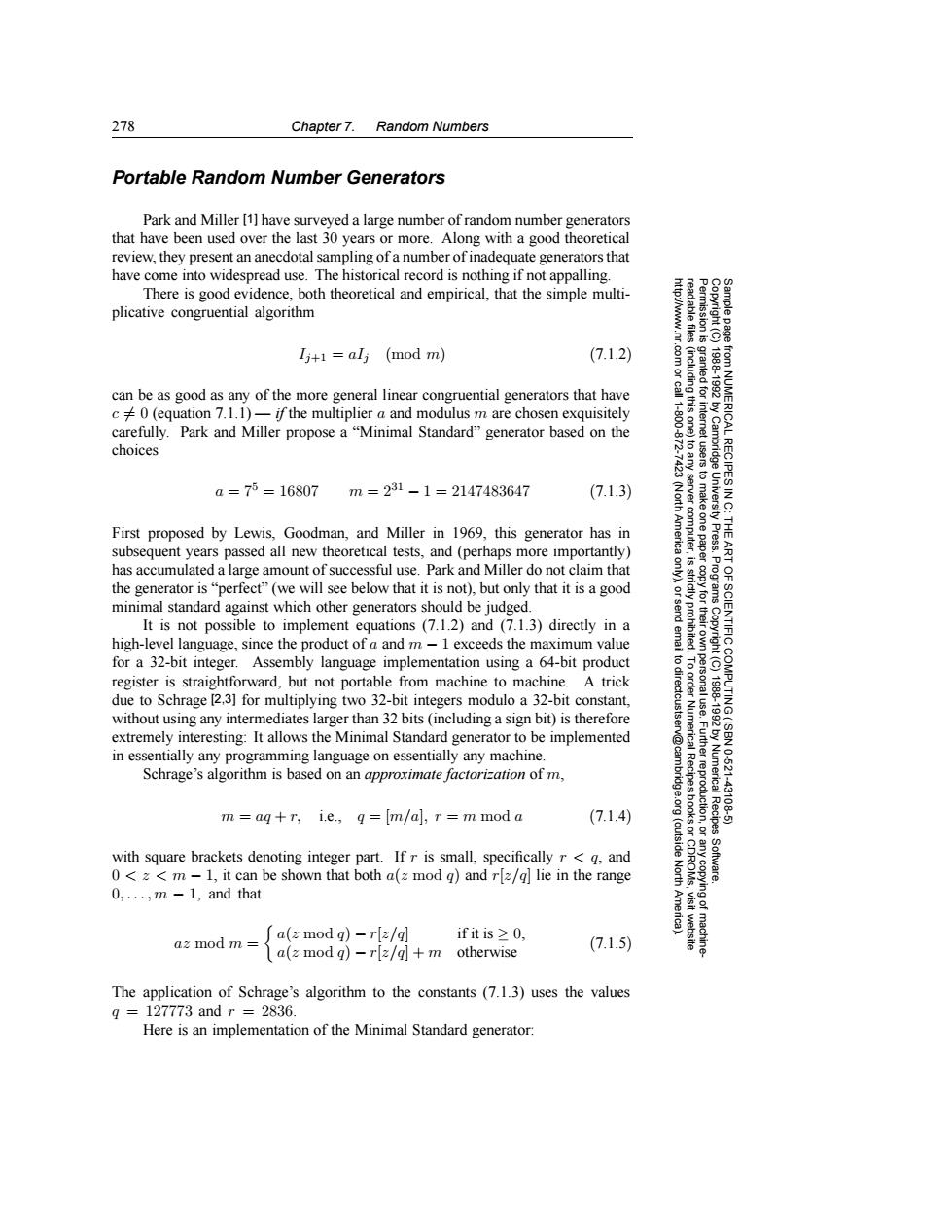正在加载图片...

278 Chapter 7.Random Numbers Portable Random Number Generators Park and Miller [1]have surveyed a large number of random number generators that have been used over the last 30 years or more.Along with a good theoretical review,they present an anecdotal sampling of a number of inadequate generators that have come into widespread use.The historical record is nothing if not appalling. There is good evidence,both theoretical and empirical,that the simple multi- plicative congruential algorithm Ij+1=alj (mod m) (7.1.2) can be as good as any of the more general linear congruential generators that have c0(equation 7.1.1)-if the multiplier a and modulus m are chosen exquisitely carefully.Park and Miller propose a "Minimal Standard"generator based on the choices RECIPES a=75=16807m=231-1=2147483647 (7.1.3) 9 First proposed by Lewis,Goodman,and Miller in 1969,this generator has in subsequent years passed all new theoretical tests,and(perhaps more importantly) has accumulated a large amount of successful use.Park and Miller do not claim that the generator is"perfect"(we will see below that it is not),but only that it is a good minimal standard against which other generators should be judged. It is not possible to implement equations (7.1.2)and (7.1.3)directly in a high-level language,since the product of a and m-1 exceeds the maximum value IENTIFIC for a 32-bit integer.Assembly language implementation using a 64-bit product 6 register is straightforward,but not portable from machine to machine. A trick due to Schrage [2.3]for multiplying two 32-bit integers modulo a 32-bit constant, without using any intermediates larger than 32 bits (including a sign bit)is therefore extremely interesting:It allows the Minimal Standard generator to be implemented in essentially any programming language on essentially any machine. Schrage's algorithm is based on an approximate factorization of m, Numerica 10.621 43126 m=aq+r,i.e.,q=[m/al,r =m mod a (7.1.4) with square brackets denoting integer part.If r is small,specifically r<q,and 腿 0<z<m-1,it can be shown that both a(z mod g)and r[z/g]lie in the range North 0,...,m-1,and that ∫a(z mod q)-rlz/g ifit is >0. az mod m= a(z mod q)-r[z/g]m otherwise (7.1.5) The application of Schrage's algorithm to the constants(7.1.3)uses the values q=127773andr=2836. Here is an implementation of the Minimal Standard generator:278 Chapter 7. Random Numbers Permission is granted for internet users to make one paper copy for their own personal use. Further reproduction, or any copyin Copyright (C) 1988-1992 by Cambridge University Press. Programs Copyright (C) 1988-1992 by Numerical Recipes Software. Sample page from NUMERICAL RECIPES IN C: THE ART OF SCIENTIFIC COMPUTING (ISBN 0-521-43108-5) g of machinereadable files (including this one) to any server computer, is strictly prohibited. To order Numerical Recipes books or CDROMs, visit website http://www.nr.com or call 1-800-872-7423 (North America only), or send email to directcustserv@cambridge.org (outside North America). Portable Random Number Generators Park and Miller [1] have surveyed a large number of random number generators that have been used over the last 30 years or more. Along with a good theoretical review, they present an anecdotal sampling of a number of inadequate generators that have come into widespread use. The historical record is nothing if not appalling. There is good evidence, both theoretical and empirical, that the simple multiplicative congruential algorithm Ij+1 = aIj (mod m) (7.1.2) can be as good as any of the more general linear congruential generators that have c = 0 (equation 7.1.1) — if the multiplier a and modulus m are chosen exquisitely carefully. Park and Miller propose a “Minimal Standard” generator based on the choices a = 75 = 16807 m = 231 − 1 = 2147483647 (7.1.3) First proposed by Lewis, Goodman, and Miller in 1969, this generator has in subsequent years passed all new theoretical tests, and (perhaps more importantly) has accumulated a large amount of successful use. Park and Miller do not claim that the generator is “perfect” (we will see below that it is not), but only that it is a good minimal standard against which other generators should be judged. It is not possible to implement equations (7.1.2) and (7.1.3) directly in a high-level language, since the product of a and m − 1 exceeds the maximum value for a 32-bit integer. Assembly language implementation using a 64-bit product register is straightforward, but not portable from machine to machine. A trick due to Schrage [2,3] for multiplying two 32-bit integers modulo a 32-bit constant, without using any intermediates larger than 32 bits (including a sign bit) is therefore extremely interesting: It allows the Minimal Standard generator to be implemented in essentially any programming language on essentially any machine. Schrage’s algorithm is based on an approximate factorization of m, m = aq + r, i.e., q = [m/a], r = m mod a (7.1.4) with square brackets denoting integer part. If r is small, specifically r<q, and 0 <z<m − 1, it can be shown that both a(z mod q) and r[z/q] lie in the range 0,...,m − 1, and that az mod m = a(z mod q) − r[z/q] if it is ≥ 0, a(z mod q) − r[z/q] + m otherwise (7.1.5) The application of Schrage’s algorithm to the constants (7.1.3) uses the values q = 127773 and r = 2836. Here is an implementation of the Minimal Standard generator: